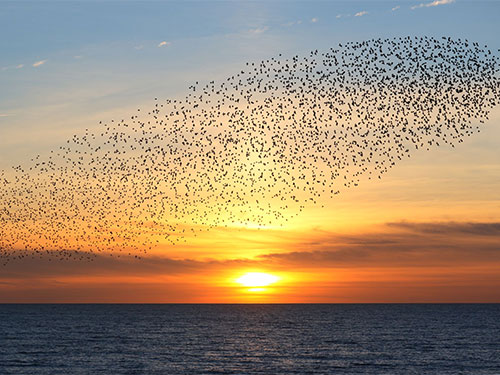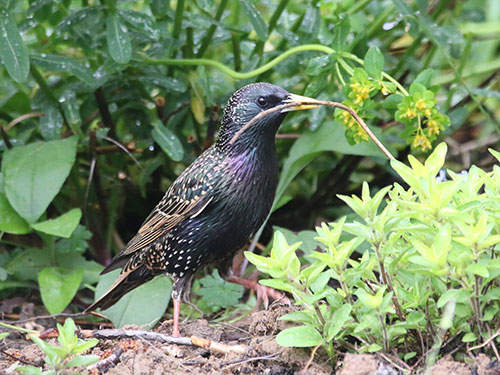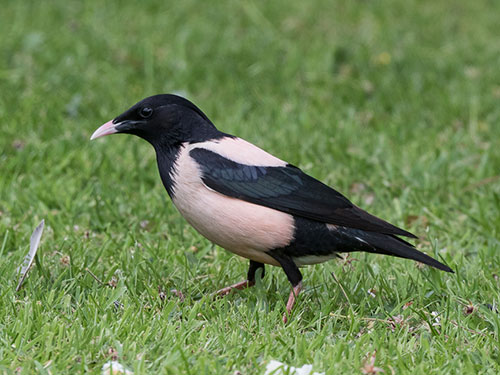


Common Starlings at Brighton
Photo: Sandra Palme

Common Starling with nesting material
Photo: Mark Mallalieu
As I write this, in late April, most Starlings are busily feeding their unfledged young, though one nearby pair appear to have lost their brood to a Magpie and are rebuilding their nest in the same place using bits of loose thin tree root from my garden, a by-product of my lockdown lawn enlargement. Although Starlings still use natural holes in trees and crevices in rocks to nest, many now find many suitable cavities in man-made structures, for example between the roofs and guttering of our houses. They are a widespread species across Sussex at all seasons.
My ‘lockdown walk’ takes me to a pasture 500m away, where small flocks of Starlings have been finding plenty of invertebrates, probably leatherjackets, to take back to their nests. Such feeding sites are essential for breeding Starlings. In the recent fine weather, Starlings have also been showing off their flycatching skills, with rapidly fluttering wings, glides and quick changes of direction almost (but not quite!) as agile as the flight of a hawking swallow.
When you read this, there should be lots of dowdy brown young Starlings noisily accompanying their parents on feeding forays, perhaps in your garden or on nearby fields. Have you watched Starlings searching for insect prey under a lawn? The birds have a rapid and apparently random probing technique in which they jab, then open their bills to create a small hole into which they peer with eyes rotated forward, quite unlike the deliberate “run, pause, run, sideways watch and strike” of a Blackbird. And then the Starlings are off, the whole flock launching into the air and vanishing, with no clue as to what spooked them, if anything.
Watch them as they perch on TV aerials too. Listen to their exotic array of vocalisations, often mimicking other birds. Writing this, I’ve still not seen a Swift, but I have been fooled by my local Starlings imitating a screaming Swift; and during the Hawfinch influx of 2017/18, the Starlings in the Sussex village of Fletching quickly learnt to copy the hard “tzik” of the Hawfinches that were feeding in the churchyard Yews.

Adult Rose-coloured Starling
Photo: John Clarkson
So the spangle-suited Starling is a real character that can give much pleasure to the locked-down naturalist. You might think that there are unlimited food sources and nesting places for them, but they have been declining in the UK, probably linked to agricultural changes and reduced areas for foraging. They are now a Red-listed species of high conservation concern. Ringing recoveries have shown that our breeding birds are augmented in winter by immigrants from eastern Europe as far away as Russia. You have probably seen, at least on television, the swirling murmurations of tens of thousands of wintering Starlings over the Somerset Levels; in Sussex, the piers used to host large roosts, including an estimated one million on Eastbourne pier in January 1998. Numbers are now far lower (there is an excellent paper in the 2018 Sussex Bird Report on roosts in Brighton, written by Chris Barfield); last winter the largest Sussex roost count was of 7800 on Brighton’s Palace pier. Why the bizarre shapes in the flocks of Starlings as they move like amoebas on fast forward across the sky? It is probably a strategy to avoid predators, which in Sussex means Peregrines and Sparrowhawks, the flocks bunching tightly when threatened to make it hard for the attacker to find a target.
I hope I’m not tempting fate here, but the warm April weather brought exceptional numbers of Hoopoes to Sussex and I wonder if they will be followed by the Common Starling’s more colourful cousin, the Rose-coloured Starling, a rare visitor from eastern Europe, which sports in adult plumage a pink body and black head, wings and tail; the young are like a washed-out version of a young Common Starling. Rose-coloured Starlings do have a habit of turning up in gardens so you might get lucky.
Mark Mallalieu
Recorder Sussex Ornithological Society
Every month it is our aim to highlight a species that is “in-season” and, although not necessarily rare or difficult to identify, has been highlighted by our local recording groups as being somewhat under-recorded and for which new records would therefore be welcomed.
If you or your recording group are aware of species such as this then please contact Bob Foreman.